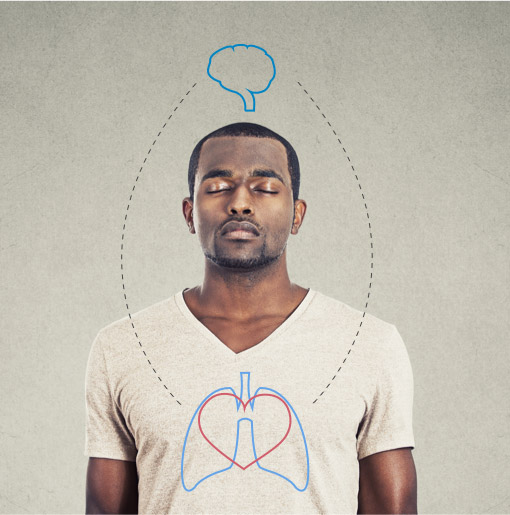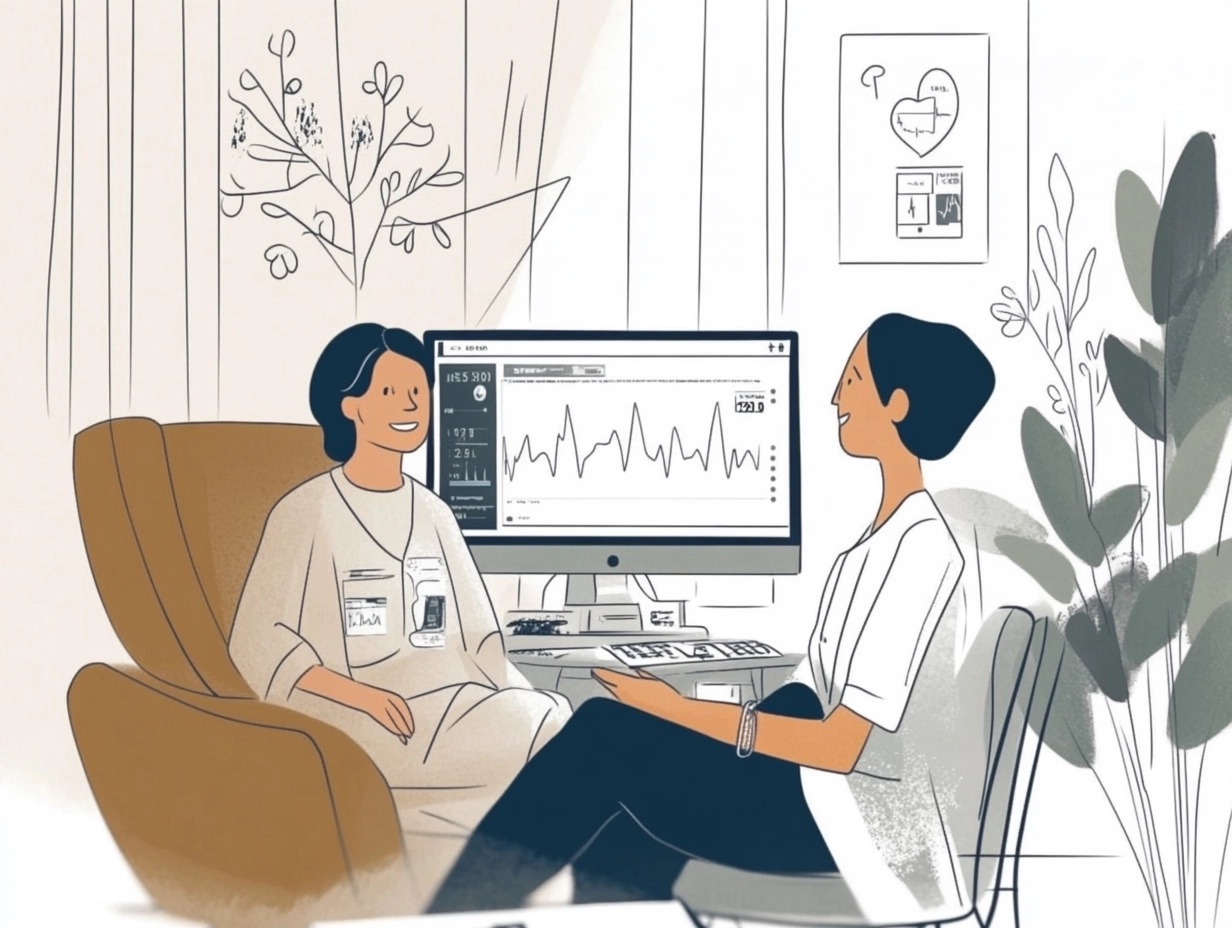Advances in technology are enabling healthcare to become more personalized to the individual. As a result, we now have more insight into how our body reacts to specific triggers than ever before.

You probably know that certain behaviors and environments affect your health. But what changes would you make if you had concrete data to verify or dismantle your assumptions? Continuous, real time heart rate variability tracking through a wearable Smart Patch can help provide that clarity.
What does my heart rate variability (HRV) tell me?
HRV is a reliable, non-invasive biomarker of stress. It’s regulated by our autonomic nervous system, which is composed of the sympathetic (“fight or flight”) and parasympathetic (“rest and repair”) branches. The sympathetic response activates the production of stress hormones, which leads to the constriction of blood vessels, increases cardiac output, and decreases HRV. In contrast, the parasympathetic response slows the heart rate and increases HRV to repair the body and restore homeostasis.

The dynamic interplay of these two branches allows our heart to respond efficiently to different triggers and situations. Our body’s are designed to be able to modulate our heart rate and blood pressure from second to second throughout the day depending on our activity and inner state. This allows us to react quickly to challenges in the moment, but relax and recover once that moment has passed.
The importance of a balanced autonomic nervous system
When the autonomic nervous system is functioning optimally, HRV increases during rejuvenating activities (e.g., sleep, meditation, etc.) when the parasympathetic mode is activated. In contrast, when mental, emotional, or physical stress is present, HRV decreases as the sympathetic mode activates to help power the body through demanding situations.
Higher HRV means the body can quickly change its heart rate depending on the context. In other words, the body is well equipped to tolerate stress, or recover efficiently from prior stress. In contrast, lower HRV indicates the body is currently under some form of stress, including accumulated stress. Chronic stress can lead to feeling constantly tense and reactive, even when there is no threat or challenge present to warrant such a response.
Does this mean low heart rate variability is bad?
Fluctuating HRV throughout the day is natural based on what you’re doing and how much stress you’re under. In general, HRV tends to be higher when you’re in a state of calm and your heart is beating more slowly, and lower when your heart is beating more quickly due to physical, mental, or emotional stress. Keep in mind that low HRV is normal at times, depending on what you’re doing and how you’re feeling.
For example, during exercise, you’re intentionally putting your body under physiological stress. In this case, low HRV is expected since you’re purposefully activating your nervous system’s sympathetic mode to pump oxygenated blood throughout your body to power your muscles.

The goal is not to be in a parasympathetic state all day long no matter what, since our sympathetic response should be activated at times. Instead, the goal is to support a balanced, efficient autonomic nervous system response that knows when to react and when to recover.
Low HRV is problematic when it’s continuously sustained, indicating that you’re chronically experiencing mental or physical stress. When that happens, your autonomic nervous system can become imbalanced. As a result, you may find yourself in a sympathetically dominant “fight or flight” state constantly.
When the body and mind is chronically tense, it contributes to various mental and physical health issues, such as feeling “on edge” throughout the day — a core symptom of anxiety. Fortunately, there are many actions you can take to help increase your HRV and rebalance your autonomic nervous system.

What factors influence HRV?
HRV as a metric simply tells you the overall state of your nervous system, but it doesn’t specifically tell you what’s causing the response. Thus, in addition to tracking your HRV continuously in real time with the clinical grade Lief Smart Patch, it’s helpful to take note of your lifestyle factors, like sleep quality, exercise habits, diet, etc. Doing so will enable you to identify how different behaviors are affecting you, and make adjustments (informed by your Lief’s real time biomarker data!) to better support your mental and physical health.
Factors within your control that impact HRV:
Sleep habits: Poor sleep quality, or not enough sleep can contribute to lower heart rate variability. Studies have also shown that night shift work over many years can reduce heart rate variability due to the chronodisruption.
Alcohol: Drinking alcohol beyond a moderate amount, defined as 1 drink per day for women and 2 drinks per day for men, can lower heart rate variability
Smoking cigarettes: Both active and passive smoking can lower heart rate variability
Physical activity: Those who live an active lifestyle can increase their autonomic nervous system’s parasympathetic activity, which results in an increase in their heart rate variability. Exemplifying this fact, endurance athletes typically have higher heart rate variability relative to the general population. Related to physical activity, heart rate variability tracking can be used to optimize fitness routines based on your readiness for physical stress on any given day.
Stress management: Increased stress, worry, or anxiety can all contribute to lower heart rate variability. Thus, effective coping skills that bring in tools like meditation, gratitude journaling, and heart rate variability biofeedback are key to mitigating the negative effects of stress.
Caffeine intake: Drinking a strong cup of coffee on an empty stomach can activate your sympathetic response, lowering heart rate variability.
Posture: A slouched posture that obstructs airflow can lower your heart rate variability. In addition, being upright versus lying down can lower heart rate variability in some individuals.
Diet: Heavier meals high in saturated or trans fats and high glycemic carbohydrates have been found to reduce heart rate variability, in contrast with a Mediterranean diet and lighter meals high in omega-3 fatty acids, B-vitamins, and probiotics, which have been shown to shown to benefit heart rate variability.
Additional factors that impact HRV:
Genetics: Healthy heart rate variability is relative and specific to the individual — whereas one healthy person may regularly average in the 60s, another equally healthy individual may regularly average in the 20s. This does not necessarily mean that one person is healthier than the other. Thus, comparing your HRV data relative to your own baseline is necessary in order to derive meaningful conclusions.
Age: Heart rate variability tends to naturally decrease as we get older
Gender: Women tend to have slightly lower heart rate variability than men
Chronic health conditions: Those with chronic health conditions like diabetes, hypertension, chronic obstructive pulmonary disease, anxiety, or depression are more likely to have lower heart rate variability
Medications: Some medications (e.g. beta blockers, ACE inhibitors, antiarrhythmics and psychotropic drugs) have been found to have a direct or indirect influence on heart rate variability.
Climate: Heat and pollution increases sympathetic nervous system activity, which will reduce heart rate variability.
Noise: Excessive noise can lead to a decrease in heart rate variability because it increases sympathetic nervous system activity.
Why should I try to train my HRV higher?
Although HRV is determined in part by genetics, lifestyle decisions still have significant impact. Establishing habits that support your mental, emotional, and physical health early on, and help increase your HRV, will have a compounding positive effect on the rest of your life. High HRV is indicative of a healthy heart, and is associated with reduced morbidity and mortality, as well as improved psychological well-being and quality of life.

One of the best ways to improve heart rate variability is through regular exercise. You can experience the benefits of consistent exercise in less than 2 months. Aim to engage in moderate exercise (e.g., cardio, resistance training, high intensity interval training, etc.) for about 20 minutes per day, or two and a half hours total each week. Just keep in mind that too much exercise can stress out your system, so carve out time to recover throughout the week, and increase your exercise challenge gradually (5-10%) each week. As a result, you’ll be training your heart to be more adaptive and healthier for a longer period of time.
Biofeedback exercises, like Lief’s Downtime practice, and mindfulness exercises can also help improve HRV and heart health in general. Deep, controlled breathing exercises help activate your parasympathetic nervous system response, helping your body and mind relax. Then, you can revisit challenging emotions and thoughts with the greater clarity that comes from detachment. The goal is to build resilience and effective coping strategies so that you feel empowered to control how your body reacts to stress.

Knowing you have the power to change how your body and mind react to stress is key to being motivated to build healthier habits each day that help you become more emotionally, mentally, and physically resilient over time.




Leave a Reply
You must be logged in to post a comment.